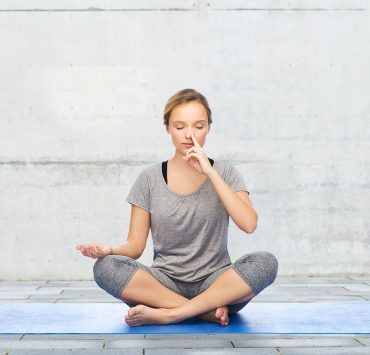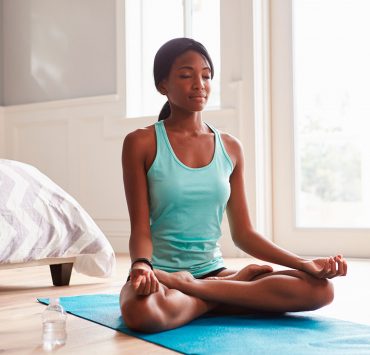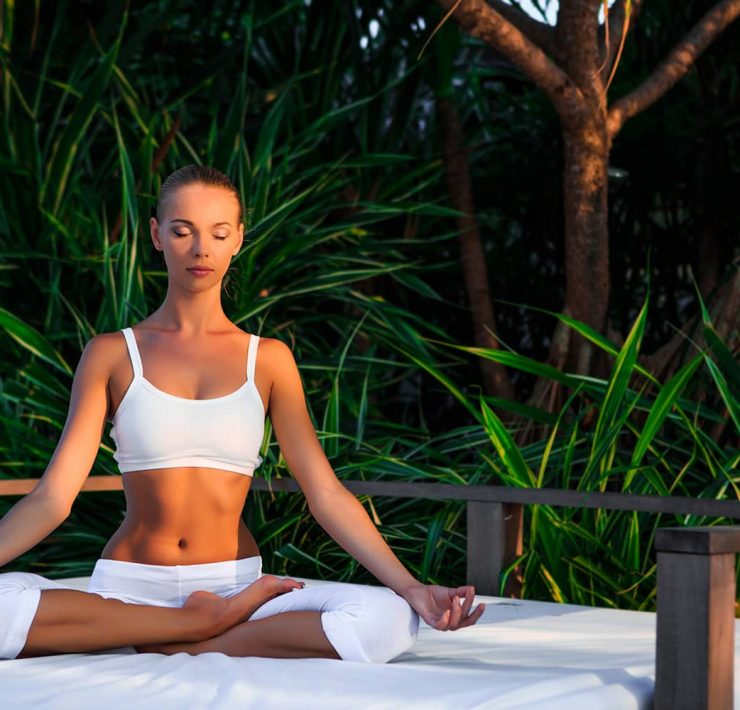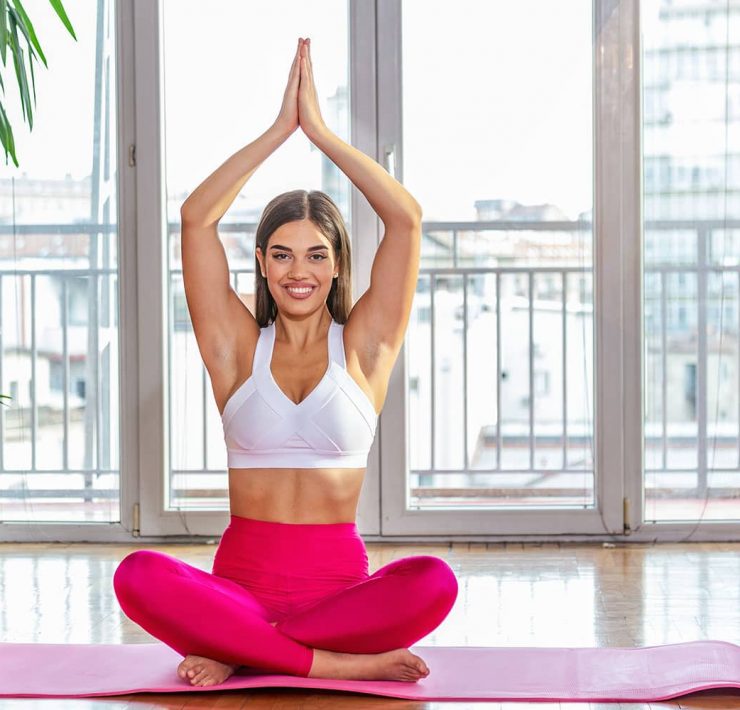
Having been a teacher’s assistant at over 50 yoga teacher…
The word “chakra” originates from the Sanskrit language. In English, we spell it a little differently. In Sanskrit, the word is “cakra.” The word literally means “wheel” or “circle.” The word “chakra” also has Indo-European roots and is related to the Greek word “kuklos” which means, “cycle.” Very early Hindu texts mention the word in connection to karma and later in the Upanishads the word is used to describe spiritual vortexes in the body. This is how the word is used in yoga and subtle energy body practices today.
Root Chakra — Muladhara

The root chakra, which is usually represented by the color red, is the first chakra on the body and it is located at the base of the spine. The root chakra is known as the center for survival. Here, all of your basic needs are considered. This chakra is often regarded as governing your primal instincts.
The Sanskrit word for the root chakra is “muladhara.” Sanskrit is a tonal language, so actually saying the Sanskrit word for the chakras will provide energy healing benefits. In English, the word “muladhara” translates to “root support.” This helps to reinforce the idea that the root chakra is the point where all subtle energy in the body begins.
Yoga Poses To Activate the Root Chakra
Depending on what is going on in your physical or emotional life, imbalances of the root chakra can show up in different ways. The chakra can be both too open or too closed. In this article from The Chopra Center, author Michelle Fondin states that imbalances in the root chakra often show up as “anxiety, fear, or nightmares.” She also mentions physical problems with the bladder, bowels, and lower back.
Some yoga poses that balance and open the root chakra are:
1. Pavanamuktasana, knee to chest pose
2. Virabhadrasna 1, Warrior I Pose
3. Janu Sirsansana, head to knee pose
4. Padmasana, lotus flexion
5. Malasana, squatting pose
6. Savasana, Corpse Pose
Sacral Chakra — Svadishthana

This chakra is the second energy center on the body and it is represented by a luscious glowing orange color. The sacral chakra is the creativity center of the body, and not surprisingly represents your divine power of creation, including your powers for sexuality and childbirth. The pelvic chakra is called “svadishthana” in Sanskrit, and in English this means “one’s own base.” You will often see this chakra represented as a 6-petaled lotus, with each petal representing a different mode of consciousness. This chakra is very emotional and highly connected to the unconscious mind. Because of its connection to sexuality, physically this chakra reigns over the reproductive organs.
Yoga Poses To Activate the Pelvic Chakra
According to this article from MindValley, this chakra controls feelings of pleasure, passion, and intimacy. When this chakra is in balance, life feels joyful and creative. People with a blocked sacral chakra might experience intimacy issues, be over sexual, or feel lots of guilt, shame, and emotional pain. In the article, the author states some very sage advice about balancing this chakra. “One of the most positive things about balancing sacral chakra is that all it really requires is for you to do more of what makes you happy. It’s doing all the simple things, dance and sing like no one’s watching or do simple exercises regularly like yoga or just go for a run.”
If yoga is something you enjoy (and it probably is!) try these poses to bring balance to the sacral chakra:
1. Supta Bhaddha Konasana, Reclining Butterfly Pose
2. Dhanurasana, Bow Pose
3. Kapotasana, Pigeon Pose
4. Mandukasana, Frog Pose
5. Ananda Balasana, Happy Baby
Naval Chakra — Manipura

When most people think about the naval chakra, they think of having a flat stomach or 6-pack abs. While physical fitness is beneficial, the naval chakra is so much more than that! In Sanskrit, the word for the naval chakra is “manipura.” In English, this translates to “jewel city.” Isn’t that beautiful? This chakra is located in the stomach region slightly below the solar plexus. The color of this chakra is yellow, so if you are trying to summon up your personal power, consider wearing the color yellow or working with yellow crystals. The manipura chakra reigns over your digestions and metabolism, but it also links to your sense of self.
Yoga Poses To Activate the Naval Chakra
In a wonderful article about balancing the naval chakra, Yoga Journal author Stephanie Snyder states that imbalance in this chakra can show up in different ways depending on the person. She states, ” In some it manifests as aggressive, overly rigid, or controlling behavior, in others it breeds a victim mentality, neediness, and lack of direction or self-esteem to stand up and take positive action.”
In order to balance this chakra, consider these yoga poses:
1. Cat Cow Pose
2. Phalakasana, Plank
3. Navasana, Boat Pose
4. Virabhadrasana III, Warrior III Pose
5. Balasana, Child’s Pose
6. Trikonasana, Triangle Pose
Heart Chakra — Anahata

The heart chakra is represented by a sparkling green color. When in balance, this chakra helps us to feel all of the love and beauty within other people, our surroundings, and ourselves. In Sanskrit the word for this chakra is “anahata.” In English, this word translates to “unstruck,” which says so much about the human capacity to love. Other than encompassing the heart, this chakra also covers the thymus gland, which produces hormones and regulates the immune system. This chakra is considered to be very special because it is a bridge chakra; this means it connects your lower chakras, which govern your earthly needs, and desires with the upper chakras that house your spiritual aspirations.
Yoga Poses To Activate the Heart Chakra
Of course, this chakra is located in the center of the chest. If this chakra is out of balance, you might feel defensive, closed off to others, jealous, codependent, or isolated. Holding grudges and being reluctant to forgive others is also a huge indicator that the heart chakra is out of balance.
To open and align this chakra, consider heart-opening poses like:
1.Urdhva Dhanurasana, Full Wheel Pose
2. Ustrasana, Camel Pose
3. Bhujangasana, Cobra Pose
4. Restorative supported backbends
5. Garudasana, Eagle Pose
6. Matsyasana, Fish Pose
Throat Chakra — Vishuddhi

The throat chakra is energy center of the body that helps you speak your truth and listen compassionately to others. This chakra governs the throat, ears, neck, mouth, tounge, and thyroid gland. In Sanskrit, the throat chakra is called “vishuddhi.” In English, this translates to “especially pure,” which is incredibly interesting when you think about how you may use your words. This chakra is usually represented by the color blue, and when it is in balance you will find it easy to say what you mean and communicate with others in a healthy way. When this chakra is out of balance, you might find yourself being very quiet in social situations or speaking unconsciously. Everyone has had the experience of saying something you didn’t mean, but bringing this chakra into balance can help you be more mindful.
Yoga Poses To Activate the Throat Chakra
In an article by The Chopra Center, author Michelle Fondin quotes expert Dr. David Simon. He states three ancient principals one should consider before speaking. He states them as:
1. First, ask yourself, “Is what I am about to say true?”
2. If so, proceed to the second gateway and ask, “Is what I am about to say necessary?”
3. If the answer is yes, go to the third gateway and ask yourself, “Is what I am about to say kind?”
In combination with this exercise, you can also bring the throat chakra into balance using yoga. Some poses to consider are:
1. Sarvangasana, Shoulder Stand
2. Halasana, Plow
3. Matsyasana, Fish Pose
4. Simhasana, Lions Breath
5. Bhujangasana, Cobra Pose
Eyebrow Chakra — Ajna

If you have ever had a brush with a psychic or intuitive person, you have seen the eyebrow chakra at work! This chakra is often referred to as “your mind’s eye,” or your “third eye.” This chakra helps you see into inner and outer worlds, and connects you to the power of clear though and spiritual reflections. According to this article from Chakra Anatomy, ” Through the gift of seeing we can internalize the outer world and with symbolic language we can externalize the inner world.” That is the power of the third eye. In Sankrit, this chakra is called “ajna.” In English, this is translated to “perceive,” “command,” or “beyond wisdom.”
Yoga Poses To Activate the Eyebrow Chakra
When this chakra is in balance, you might find it easy to connect to your inner wisdom, intuition, and imagination. This chakra is represented by the color purple, so if you feel this chakra is out of balance, wearing and incorporating more purple into your life can be helpful. When this chakra is out of balance, you might experience vision problems, eyestrain, and headaches.
To balance and activate this chakra, consider these yoga poses:
1. Ardha Pincha Mayurasana, Dolphin Pose
2. Janusirsasana, Head to Knee Pose
3. Virasana, Hero Pose
4. Arha Uttanasana, Standing Half Forward Bend
5. Adho Mukha Svanasana, Downward Facing Dog
Crown Chakra — Sahasrara

The crown chakra sits right above the head. This chakra is a mixture of pure white and light purple, and it connects you to your higher self and God. This chakra is called “sahasrara” in Sanskrit, which translates to “thousand-petaled” in English. This chakra is usually represented as a thousand-petaled lotus. This chakra is the seventh chakra and is at the top of the chakras on the body. All subtle energy moves between the chakras 1-7; so while the root chakra connects us to Earth, the crown chakra connects us to the ethereal realms.
Yoga Poses To Activate the Crown Chakra
When this chakra is healthy, open, and in balance, you will feel a deep gratitude and reverence for life. This chakra represents the timelessness of the soul and elevated consciousness. To activate this chakra, you can do many practices like yoga, pranayama and meditation. Some yoga poses to consider are:
1. Salamba Sirhasana, Headstand
2. Savasana, Corpse Pose
3. Makarasana, Crocodile Pose
4. Supta Padangusthasana, Supine Hand-to-Big-Toe Pose
5. Parsvakonasana, Side Angle Pose
Yoga Poses To Align All 7 Chakras
Of course, each chakra isn’t cut off from one another. The energy flows freely through each chakra, and ultimately you will benefit most from all of the chakras being in alignment. Sequences like the Sun Salutations A, B, and C work very well to activate all of the chakras and bring them all into balance. You may also consider activities like pranayama. Some pranayama exercises that balance all of the chakras are:
1. Nadi Shodhana, Alternate Nostril Breathing
2. Kapalabhati, Skull Shining Breath
These practices are best done after a yoga warm-up and only if you feel relaxed and comfortable. When practicing pranayama, make sure you are sitting up straight with your hips elevated above your knees, like on a meditation cushion or folded blanket. This action helps to keep the chakras in alignment during the breath work. Also, be sure that you are not reverse breathing; the breath should move smoothly from the bottom of the lungs to the top upon inhale, and from the top of the lungs to the bottom during exhale.
What's Your Reaction?
Having been a teacher’s assistant at over 50 yoga teacher trainings worldwide, Rebecca Rebecca has a firm grasp on the fine art of yoga and meditation. In her work, she carefully reflects on a vast expanse of knowledge to help others find peace in both body and mind.














